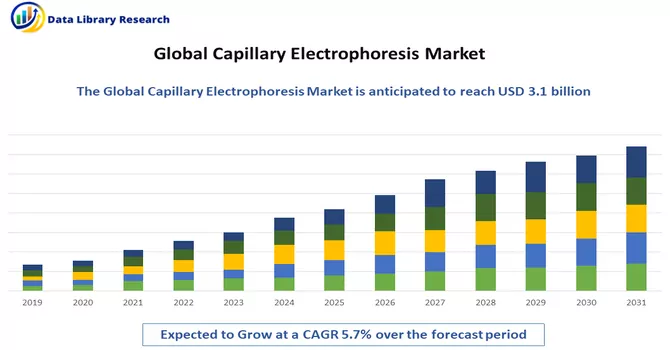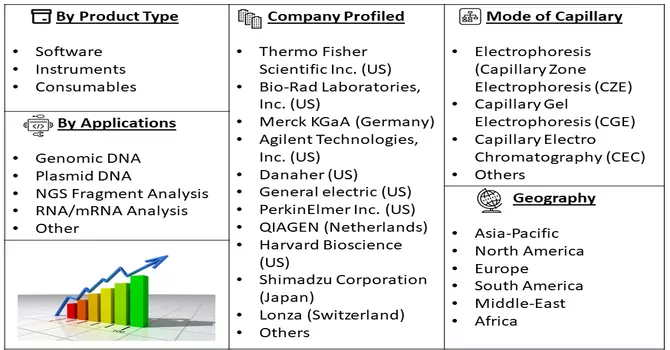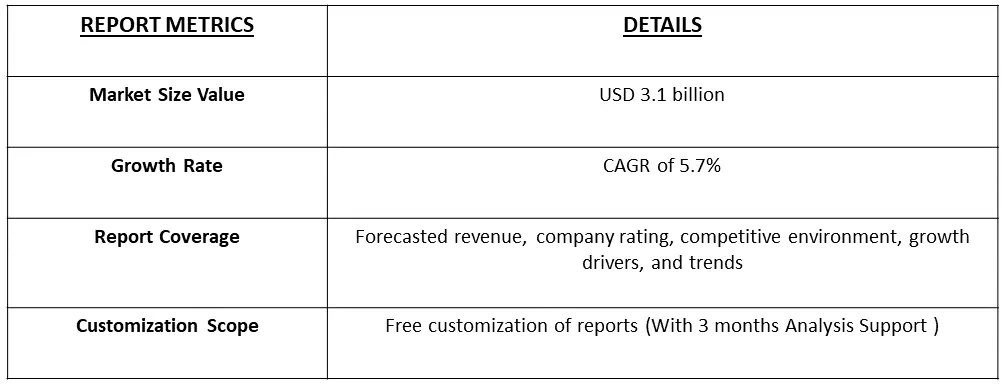The global Capillary electrophoresis market in terms of revenue was estimated to be worth $3.1 billion in 2023 and is poised to grow at a CAGR of 5.7% forecast period, 2024-2031.

Get Complete Analysis Of The Report - Download Free Sample PDF
Capillary Electrophoresis (CE) is a powerful analytical technique used in chemistry and biochemistry to separate and analyze ions, molecules, and particles based on their charge and size. It involves the migration of charged analytes through a narrow capillary tube under the influence of an electric field.The key components of capillary electrophoresis include a fused silica capillary tube, buffer solution, and electrodes. The capillary, typically made of silica due to its high resistance to chemical reactions, serves as the separation column. The buffer solution, also present in the capillary, provides the medium through which analytes migrate. An electric field is applied across the capillary, inducing the movement of charged species. CE offers several advantages over traditional electrophoresis and chromatographic techniques. It allows for high-resolution separations in a short period, often within minutes, due to the small diameter of the capillary and the resulting low thermal mass. Additionally, CE is highly sensitive and requires minimal sample volume. It finds applications in various fields, including biochemistry, environmental analysis, pharmaceuticals, and DNA sequencing, making it a versatile and widely used analytical method.
The Capillary Electrophoresis (CE) market is propelled by several key factors, including the increasing emphasis on research and development across scientific domains such as genomics and proteomics. The technology's pivotal role in proteomic and genomic analysis, driven by the demand for personalized medicine and biomarker discovery, contributes to its market growth. Ongoing advancements in CE technology, encompassing improved detector sensitivity and miniaturization, enhance system performance and attract users seeking higher resolution and throughput. CE's widespread applications in pharmaceutical drug development, environmental monitoring, and food safety, coupled with its suitability for small sample volumes and high-throughput processes, further drive its adoption. The infusion of funds into life sciences research, collaborations among research institutions and industry players, and stringent regulatory requirements in fields like pharmaceuticals and food safety collectively contribute to the expanding market for Capillary Electrophoresis.
Market Segmentation: Global Capillary Electrophoresis Market, By Product Type (Software, Instruments and Consumables), Mode of Capillary Electrophoresis (Capillary Zone Electrophoresis (CZE), Capillary Gel Electrophoresis (CGE), Capillary Electro Chromatography (CEC), Others), Applications (Genomic DNA, Plasmid DNA, NGS Fragment Analysis, RNA/mRNA Analysis, Other), and Geography (North America, Europe, Asia-Pacific, Middle-East and Africa, and South America). The market provides the value (in USD million) for the above segments.

For Detailed Market Segmentation - Download Free Sample PDF
The Capillary Electrophoresis (CE) market is anticipated to witness several key trends, reflecting the dynamic landscape of analytical technologies. Ongoing technological advancements, including enhanced capillary coatings, improved detector sensitivity, and increased automation, are expected to drive market growth by offering higher resolution and efficiency. The integration of microfluidic technologies into CE systems is gaining prominence, aiming to enhance portability and decrease sample consumption. The market is poised to experience an expansion of applications across industries such as pharmaceuticals, life sciences, environmental monitoring, and food safety, owing to the versatility of CE in analyzing various molecules. The demand for high-throughput analysis and the continuous growth in proteomics and genomics research are likely to be key drivers, and collaborations between industry players and research institutions are anticipated to foster innovation in CE technologies. For the latest insights, referring to the most recent market reports or industry publications is recommended.
Market Drivers:
Higher growth in funding for proteomic and genomic research and electrophoresis techniques
The capillary electrophoresis market is experiencing significant momentum, fueled by various factors that act as potent drivers. Notably, the escalating prevalence of communicable diseases, cancer, and genetic disorders is driving the market forward by creating a pressing demand for advanced diagnostic solutions. The increasing frequency of collaborations between industry and academia is contributing to the market's growth trajectory, showcasing a collaborative effort to address complex healthcare challenges. Additionally, the growing importance of nanoproteomics is playing a pivotal role in shaping the molecular analysis landscape. The surge in the number of forensic, clinical, and research laboratories further amplifies the demand for advanced analytical tools like capillary electrophoresis. Furthermore, the widespread adoption of Next-Generation Sequencing (NGS) and the concurrent reduction in the cost of DNA sequencing are crucial factors influencing the integration of capillary electrophoresis into cutting-edge research and diagnostics. These collective trends underscore the vital role of capillary electrophoresis in advancing the fields of healthcare and life sciences.
Genome-based drug unearthing over plant-based drug development
Moreover, the increasing demand for personalized treatment strategies and the rapid economic growth in developing nations are anticipated to open up numerous growth opportunities for the capillary electrophoresis market throughout the forecast period, spanning from 2022 to 2029. However, the market faces challenges during this period, with the presence of alternative methods boasting greater efficiency, extended functionalities, and composite actions, which may impede the overall expansion of the capillary electrophoresis market. Despite these challenges, the market's primary driving force lies in its superior efficacy, high precision, and greater reproducibility compared to alternative molecular separation and analysis techniques. Yet, the market growth is restrained by the elevated cost of equipment and the availability of alternative electrophoresis systems in the market.
Market Restrains:
The Capillary Electrophoresis (CE) market experienced several potential impacts due to the COVID-19 pandemic. Disruptions in the global supply chain likely affected the production and distribution of crucial components for CE systems, leading to delays and challenges in the availability of these analytical instruments. With a shift in research priorities towards infectious diseases and diagnostics during the pandemic, the demand for specific applications of capillary electrophoresis may have been influenced. Laboratory closures, restricted access, and budget constraints stemming from economic challenges could have hampered routine operations and impacted purchasing decisions, potentially delaying investments in new equipment. The transition to remote work may have presented challenges in conducting hands-on experiments typically associated with CE systems. Despite potential setbacks, increased demand for diagnostics during the pandemic might have driven a surge in the utilization of capillary electrophoresis systems for relevant applications. For the latest insights, consulting recent market reports and industry analyses is recommended.
The Capillary Electrophoresis (CE) market experienced several potential impacts due to the COVID-19 pandemic. Disruptions in the global supply chain likely affected the production and distribution of crucial components for CE systems, leading to delays and challenges in the availability of these analytical instruments. With a shift in research priorities towards infectious diseases and diagnostics during the pandemic, the demand for specific applications of capillary electrophoresis may have been influenced. Laboratory closures, restricted access, and budget constraints stemming from economic challenges could have hampered routine operations and impacted purchasing decisions, potentially delaying investments in new equipment. The transition to remote work may have presented challenges in conducting hands-on experiments typically associated with CE systems. Despite potential setbacks, increased demand for diagnostics during the pandemic might have driven a surge in the utilization of capillary electrophoresis systems for relevant applications. For the latest insights, consulting recent market reports and industry analyses is recommended.
Segmental Analysis:
Software Segment is Expected to Witness Significant Growth Over the Forecast Period
Capillary electrophoresis (CE) in the realm of analytical techniques relies on specific software applications for both instrument control and data analysis. Software plays a crucial role in capillary electrophoresis (CE) by providing comprehensive tools for instrument control, data acquisition, and analysis. Specialized software allows researchers to control various parameters of the CE instrument, including voltage, temperature, and injection timing. This control ensures precise and reproducible conditions for sample separation.Furthermore, the recent development in the software segment is expected to witness significant growth over the forecast period. For instance, in October 2023, Sciex, a US-based mass spectrometry instrumentation manufacturer, has launched the BioPhase 8800 driver for Empower software, seamlessly integrating it with Waters Technologies Corporation's Empower Chromatography Data System (CDS). This advancement allows scientists to directly control the BioPhase 8800 system through Empower CDS, preserving the experimental flexibility of Sciex capillary electrophoresis (CE) systems.
Nucleic acid segment is Expected to Witness Significant Growth Over the Forecast Period
The nucleic acid segment is expected to witness significant growth over the forecast period, as nucleic acid analysis by capillary electrophoresis (CE) is a rapid and high-resolution technique used for separating and quantifying DNA and RNA fragments. Its efficiency in resolving similar-sized fragments, automated sample handling, and rapid analysis make it advantageous for applications in genomics and molecular biology. The method enables accurate fragment sizing, multiplexing, and parallel analysis, supporting various tasks such as genotyping, DNA sequencing, and mutation detection. With its role in quality control and applications in biotechnological processes, CE contributes significantly to the advancement and efficiency of genetic research, molecular diagnostics, and biotechnology. Also, an article published by ACS publication in March 2023, reported that capillary electrophoresis is highly efficient in separation of nucleic acid species in gene therapy products. The study reported that For single-stranded nucleic acids up to 1000 nucleotides, the method is an excellent choice that proved to be highly specific by detecting DNA traces in complex samples. Thus, such instances show the more efficient separation of nucleic acids by capillary electrophoresis is expected to witness significant growth over the forecast period
Capillary Zone Electrophoresis (CZE) Segment is Expected to Witness Significant growth Over the Forecast Period
Capillary Zone Electrophoresis (CZE) offers several advantages in the field of analytical chemistry, particularly for the separation and analysis of small molecules. Its primary strengths include high resolution, rapid analysis, and minimal sample requirements. CZE enables the separation of complex mixtures with superior efficiency, making it a powerful tool for precise quantification and identification of analytes. The technique requires smaller sample volumes, reducing both cost and sample consumption. Additionally, CZE is adaptable to a variety of detection methods, enhancing its versatility in applications such as pharmaceutical analysis, environmental monitoring, and bioanalytical studies. The combination of these advantages positions Capillary Zone Electrophoresis as a valuable and efficient analytical technique in diverse scientific disciplines.Capillary Electrophoresis (CE) stands out as a highly advantageous analytical tool for pharmaceutical and biotechnology companies. Its exceptional high-resolution capabilities make it essential for ensuring the purity and integrity of drug compounds during manufacturing processes. CE's capacity to operate with minimal sample volumes not only contributes to cost savings but also optimizes the utilization of valuable biological samples. The rapid analysis feature enhances overall operational efficiency, enabling swift decision-making in critical aspects of drug development and quality control. The versatility of CE in analyzing diverse biomolecules, including proteins and nucleic acids, positions it as a pivotal instrument for characterizing biopharmaceuticals, monitoring product stability, and maintaining compliance with rigorous regulatory standards.In the competitive landscape of pharmaceutical and biotech industries, the efficiency, sensitivity, and adaptability of Capillary Electrophoresis significantly bolster research and development endeavors, fostering innovation and quality assurance.
North America Region is Expected to Witness Significant Growth Over the Forecast Period
North America stands as a pivotal force in the Capillary Electrophoresis (CE) market, boasting a dominant presence driven by factors such as the concentration of key industry players like Thermo Fisher Scientific and Merck KGaA. Renowned for its robust research and development activities, the region serves as a hub for technological innovation, fostering the continuous evolution of CE technologies. With a well-established healthcare and research infrastructure, including numerous clinical and research laboratories, North America witnesses significant adoption of capillary electrophoresis for applications ranging from diagnostics to molecular research. Collaborations between academic institutions, research organizations, and industry players contribute to the development of cutting-edge CE solutions, ensuring the region's sustained influence on the dynamic and competitive landscape of the market.

Get Complete Analysis Of The Report - Download Free Sample PDF
The analyzed market exhibits a high degree of fragmentation, primarily attributable to the presence of numerous players operating on both a global and regional scale. The competitive landscape is characterized by a diverse array of companies, each contributing to the overall market dynamics. This fragmentation arises from the existence of specialized solution providers, established industry players, and emerging entrants, all vying for market share. The diversity in market participants is underscored by the adoption of various strategies aimed at expanding the company presence. On a global scale, companies within the studied market are strategically positioning themselves through aggressive expansion initiatives. This often involves entering new geographical regions, targeting untapped markets, and establishing a robust global footprint. The pursuit of global expansion is driven by the recognition of diverse market opportunities and the desire to capitalize on emerging trends and demands across different regions. Simultaneously, at the regional level, companies are tailoring their approaches to align with local market dynamics. Regional players are leveraging their understanding of specific market nuances, regulatory environments, and consumer preferences to gain a competitive edge. This regional focus allows companies to cater to the unique needs of local clientele, fostering stronger market penetration. To navigate the complexities of the fragmented market, companies are implementing a range of strategies. These strategies include investments in research and development to stay at the forefront of technological advancements, mergers and acquisitions to consolidate market share, strategic partnerships for synergies, and innovation to differentiate products and services. The adoption of such multifaceted strategies reflects the competitive nature of the market, with participants continually seeking avenues for growth and sustainability. In essence, the high fragmentation in the studied market not only signifies the diversity of players but also underscores the dynamism and competitiveness that drive ongoing strategic maneuvers. As companies explore various avenues for expansion, the market continues to evolve, presenting both challenges and opportunities for industry stakeholders. Some of the market players working in this segment are:
Recent Development:
1) In 2020, the Hitachi DS3000 compact capillary electrophoresis (CE) sequencer was launched by Hitachi High-Tech Corporation in collaboration with Promega Corporation, making significant contributions to capillary electrophoresis in the United States. With a focus on enhanced capabilities, a compact design, and collaborative expertise, the DS3000 promised advanced analytical solutions for US-based research institutions and biotechnology companies.The product's potential for improved efficiency, accessibility in smaller laboratories, and a competitive impact on the market underscored the role this development played in advancing molecular biology studies and biotechnological applications across the country.
2) In October 2022, CMP Scientific Corp. has inked a global co-marketing deal with Agilent Technologies to offer an integrated Capillary Electrophoresis-Mass Spectrometry (CE-MS) solution for the life science and pharmaceutical industry. Specializing in life sciences and diagnostics, CMP Scientific will collaborate with Agilent to explore new applications for the CE-MS system, providing a sensitive alternative to liquid chromatography-mass spectrometry (LC-MS) for mapping biological components. The integration includes CMP's EMASS-II CE-MS ion source, seamlessly working with Agilent's MS instruments, facilitating the identification of therapeutic monoclonal antibody charge variants and analysis of diverse biological molecules.
Q1. What was the Capillary Electrophoresis Market size in 2023?
As per Data Library Research the Capillary electrophoresis market was estimated to be worth $3.1 billion in 2023.
Q2. At what CAGR is the market projected to grow within the forecast period?
Capillary Electrophoresis Market is poised to grow at a CAGR of 5.7% forecast period.
Q3. What are the factors on which the Capillary Electrophoresis Market research is based on?
By Product Type, By Application and Geography are the factors on which the Capillary Electrophoresis Market research is based.
Q4. Which are the major companies in the Capillary Electrophoresis Market?
Thermo Fisher Scientific Inc. (US), Bio-Rad Laboratories, Inc. (US), Merck KGaA (Germany) and Agilent Technologies, Inc. (US) are some of the major companies in the Capillary Electrophoresis Market.
Data Library Research are conducted by industry experts who offer insight on industry structure, market segmentations technology assessment and competitive landscape (CL), and penetration, as well as on emerging trends. Their analysis is based on primary interviews (~ 80%) and secondary research (~ 20%) as well as years of professional expertise in their respective industries. Adding to this, by analysing historical trends and current market positions, our analysts predict where the market will be headed for the next five years. Furthermore, the varying trends of segment & categories geographically presented are also studied and the estimated based on the primary & secondary research.
In this particular report from the supply side Data Library Research has conducted primary surveys (interviews) with the key level executives (VP, CEO’s, Marketing Director, Business Development Manager and SOFT) of the companies that active & prominent as well as the midsized organization
FIGURE 1: DLR RESEARH PROCESS

Extensive primary research was conducted to gain a deeper insight of the market and industry performance. The analysis is based on both primary and secondary research as well as years of professional expertise in the respective industries.
In addition to analysing current and historical trends, our analysts predict where the market is headed over the next five years.
It varies by segment for these categories geographically presented in the list of market tables. Speaking about this particular report we have conducted primary surveys (interviews) with the key level executives (VP, CEO’s, Marketing Director, Business Development Manager and many more) of the major players active in the market.
Secondary ResearchSecondary research was mainly used to collect and identify information useful for the extensive, technical, market-oriented, and Friend’s study of the Global Extra Neutral Alcohol. It was also used to obtain key information about major players, market classification and segmentation according to the industry trends, geographical markets, and developments related to the market and technology perspectives. For this study, analysts have gathered information from various credible sources, such as annual reports, sec filings, journals, white papers, SOFT presentations, and company web sites.
Market Size EstimationBoth, top-down and bottom-up approaches were used to estimate and validate the size of the Global market and to estimate the size of various other dependent submarkets in the overall Extra Neutral Alcohol. The key players in the market were identified through secondary research and their market contributions in the respective geographies were determined through primary and secondary research.
Forecast Model
